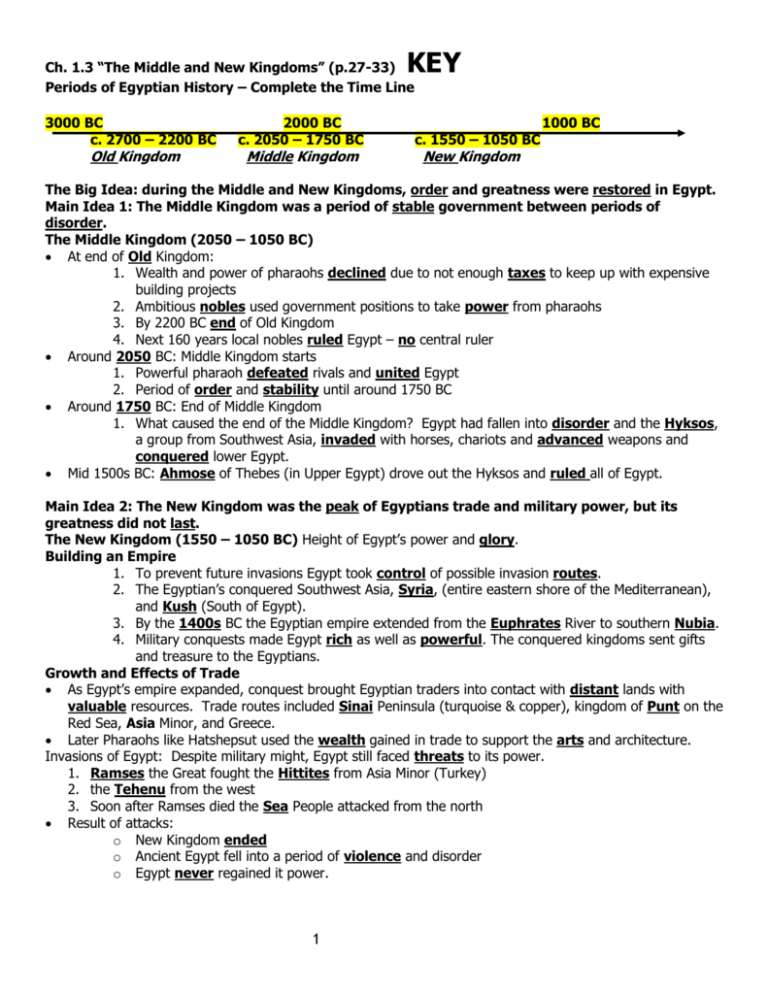1.3 answer key
advertisement

KEY Ch. 1.3 “The Middle and New Kingdoms” (p.27-33) Periods of Egyptian History – Complete the Time Line 3000 BC c. 2700 – 2200 BC Old Kingdom 2000 BC c. 2050 – 1750 BC Middle Kingdom c. 1550 – 1050 BC 1000 BC New Kingdom The Big Idea: during the Middle and New Kingdoms, order and greatness were restored in Egypt. Main Idea 1: The Middle Kingdom was a period of stable government between periods of disorder. The Middle Kingdom (2050 – 1050 BC) At end of Old Kingdom: 1. Wealth and power of pharaohs declined due to not enough taxes to keep up with expensive building projects 2. Ambitious nobles used government positions to take power from pharaohs 3. By 2200 BC end of Old Kingdom 4. Next 160 years local nobles ruled Egypt – no central ruler Around 2050 BC: Middle Kingdom starts 1. Powerful pharaoh defeated rivals and united Egypt 2. Period of order and stability until around 1750 BC Around 1750 BC: End of Middle Kingdom 1. What caused the end of the Middle Kingdom? Egypt had fallen into disorder and the Hyksos, a group from Southwest Asia, invaded with horses, chariots and advanced weapons and conquered lower Egypt. Mid 1500s BC: Ahmose of Thebes (in Upper Egypt) drove out the Hyksos and ruled all of Egypt. Main Idea 2: The New Kingdom was the peak of Egyptians trade and military power, but its greatness did not last. The New Kingdom (1550 – 1050 BC) Height of Egypt’s power and glory. Building an Empire 1. To prevent future invasions Egypt took control of possible invasion routes. 2. The Egyptian’s conquered Southwest Asia, Syria, (entire eastern shore of the Mediterranean), and Kush (South of Egypt). 3. By the 1400s BC the Egyptian empire extended from the Euphrates River to southern Nubia. 4. Military conquests made Egypt rich as well as powerful. The conquered kingdoms sent gifts and treasure to the Egyptians. Growth and Effects of Trade As Egypt’s empire expanded, conquest brought Egyptian traders into contact with distant lands with valuable resources. Trade routes included Sinai Peninsula (turquoise & copper), kingdom of Punt on the Red Sea, Asia Minor, and Greece. Later Pharaohs like Hatshepsut used the wealth gained in trade to support the arts and architecture. Invasions of Egypt: Despite military might, Egypt still faced threats to its power. 1. Ramses the Great fought the Hittites from Asia Minor (Turkey) 2. the Tehenu from the west 3. Soon after Ramses died the Sea People attacked from the north Result of attacks: o New Kingdom ended o Ancient Egypt fell into a period of violence and disorder o Egypt never regained it power. 1 Main Idea 3: work and daily life differed among Egypt’s social classes. Work and Daily Life As population grew, Egypt’s society became even more complex. A complex society requires people to take on different jobs. o How were jobs assigned? Jobs were passed on within families. Scribes: 1. Ranked below priests and Government officials --- members of the middle class 2. Kept records and accounts and copied religious and literary texts 3. Didn’t have to pay taxes --- became wealthy Artisans, Artists, and Architects: 1. Artisans: advanced skills—sculptors, builders, carpenters, metalworkers, jewelers, leather workers 2. Architects: designed temples and tombs 3. Artists: different types of art work –often worked in burial chambers painting pictures Soldiers: 1. professional army offered chance to rise in social status 2. Received land as payment 3. Allowed to keep treasure captured in war Farmers and Other Peasants: 1. bottom of social scale—majority of population 2. Grew crops to support family and gave part of crops to the Pharaoh as taxes to pay for use of land 3. Special duty = pharaoh’s projects -- building projects, mining, army; paid in grain Slaves: 1. Lowest class 2. Some were convicted criminals or prisoners from wars. 3. They had some legal rights and could sometimes earn their freedom. Family Life in Egypt 1. Men: expected to marry young and take on profession/job of father 2. Women: Most women took care of family, but some had outside jobs—priestesses, administrators, artisans a. Women’s rights: could own property, make contracts, divorce husbands 3. Children: not as structured as adults—played with toys, played ball games, hunted, boys and girls—some education—at 14 boys entered father’s profession Ramses the Great 1. Lived in the late 1300s and early 1200s BC 2. Lived in Nile Delta city—Pi-Ramsesse, 3. Army captain at age 10 4. strong military leader—increased the size of his kingdom greatly, 5. last great pharaoh, great warrior and builder 6. built many temples (Karnak, Luxor, Abu Simbel) and monuments. 2







